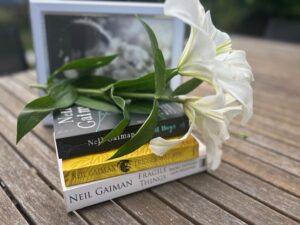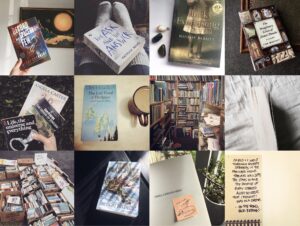As the name ‘young adult’ suggests, YA is a book category targeted towards young people. For the sake of argument, let’s say 25 years and below – although there’s definitely a wider perception that it’s made purely for high schoolers. As a 21-year-old, I grew up in the dystopian golden age of YA. The Hunger Games. Divergent. The Maze Runner. These were the series that I injected every night, and it was beautiful. I don’t know what exactly is beautiful about teenagers falling in love and then dying in mass numbers, but it definitely was. You just had to be there.
The dystopian golden age has probably slipped away, but YA is more popular than ever due to the phenomenon that is BookTok. As teenage reading rates were slipping away, an unexpected ally (social media) came to save the day. Sometimes, it be the people you least expect.
Now, we’re in the trope era of YA. You can market your book based solely on its tropes, and not its plot or concept. I’ve seen it done a million times on Reels. I’ll come away knowing that some novel’s a sapphic, enemies-to-lovers, African-American love triangle. What’s it actually about, though? No clue. But, in a way, I’ve got everything I need to know. Tropes tell me if I’m likely to enjoy the story for its entirety, whereas a concept might only drag me along for the opening few worldbuilding chapters.
YA, much like any and every art form, is ever-changing. Whether these changes are good or bad is up for debate, but the changes are all part of commercial entertainment’s natural selection. Some authors try something new, it sells really well, and publishing houses support it with generational advances and advertising supernovas. In YA’s case, the new evolution is BookTok, is tropes, is diversity.
I, personally, am pro-BookTok era. The most obvious reason being that it has single-handedly saved the publishing industry from a slow drip into oblivion amongst everyone in my generation. Although the BookTok table at your local Paper Plus might seem cringe, it’s keeping those sliding doors open. And while the trope-pumping might seem repetitive, is it really more repetitive than the gazillion Twilight copies that came out during the 2010s?
The natural selection of commercial entertainment demands something new. Otherwise, as the other entertainment mediums adapt – namely, the growing biopsychological beast that is social media – and become more efficient at entertaining, any entertainment industries refusing to change something will become out-competed. If the YA industry, and the wider literature world, didn’t adapt to BookTok, the results would’ve been, well, not ideal. I reckon hardcovers, in a few decades, would’ve become as popular with young people as vinyls are now. Literature would turn into something broke, hipster uni students collect, providing nostalgia for a more authentic time they never got to experience.
If YA must find something new to thrive, then BookTok’s success can’t merely be attributed to the trope-pushing. Tropes, by definition, are something we’ve seen before. Something we know that works – this is where the allure of trope-pushing comes from. Readers are looking for stories they know will please their taste buds. When you choose your next love triangle novel, it’s like going to different Thai restaurants, but always ordering your favourite dish. A consistent strategy for pleasure. But while this is satisfying and reliable, it’s not new. And so it’s hard to understand why the BookTok era has changed the game so much, when apps recommending novels based on your previous favourites have existed (and been popular) for ages – Goodreads being the prime example.
The evolutionary trait that the BookTok era brings is its diversity. While The Hunger Games, Divergent, and The Maze Runner all showcase similar tropes, they also showcase similar protagonists – a fairly attractive, but not jaw-dropping, white American teenager who overcomes great odds due to their smarts, wits, and bravery. They also are set in locations from a certain freedom-loving country – the Rockies, Chicago, Denver. Furthermore, their authors are of the same ethnicity… at this point, I don’t think you need to guess which one (but I’ll give a hint anyway, it’s not Mexican).
As a quick note, I love all these writers and series. I’m just making the point that maybe YA wasn’t the most diverse space in 2013. Out of all the popular YA I read when I was younger, I honestly can’t remember one book having a non-white lead.
BookTok has changed this significantly. The platform celebrates diverse casts in novels, utilises it as a positive selling point that readers (especially those of that under-represented group) can enjoy and appreciate. This has had the cascading effect of making the industry more diverse as a whole.
While I could list on and on diverse BookTok successes, I want to focus on New Zealand’s own YA BookTok queen: Chloe Gong. Gong is a 25-year-old author who attended Rangitoto College on the Shore, and is now a New York Times number one bestseller with six novel releases since her 2020 debut (seven, if you count her novella collection Last Violent Call). While I deeply hate Rangi – they always smoked me in football – I think Gong is a brilliant writer and massively underappreciated by the Aotearoa public. That goes too for a couple other Asian-Kiwi authors who I’m shocked we’re not talking about 24/7, like Graci Kim. However, the way New Zealanders treat our famous Asian-Kiwis compared to Pākehā- or Māori-Kiwis is another article in and of itself.
Going back to our Kiwi YA queen, Gong has certainly found popularity on social media. At the time of writing, she’s got just over 200 thousand followers on TikTok, and 100 thousand on Instagram. To put that in perspective, if Gong’s followers all gained New Zealand citizenship and settled down in, I don’t know, rural Waikato, they would form a city. A city that would quickly become our second most populous (way passing Wellington, and nearing Christchurch for that number two).
Gong’s most famous work is her original duology, consisting of These Violent Delights and Our Violent Ends. They’re about two teenagers in early-twentieth century Shanghai who are at the centre of a gang war and monster-in-the-night mystery. Her other work, too, accentuates and explores her Chinese heritage. If you’re keen, check out her Flesh and False Gods series for more. It’s super fun (again, in a young people falling in love and then horribly dying sort of way). Not only does this offer a unique flavour to the YA landscape, but it’s also just refreshing. It’s refreshing to see protagonists that aren’t white. It’s refreshing to see settings that aren’t future-Denver. And I think younger audiences – from a generation growing up in a more culturally diverse environment than their parents or grandparents – have really responded to how enjoyable it is to read different stories, inspired by different cultures around the world.
As a young Māori YA writer, this makes me wonder: is there space for Māori stories in this industry? I think there is. BookTok’s gaze – for all the aforementioned reasons – seems perfectly suited for Polynesian and/or Māori YA. It yearns for something different. It cheers on underrepresented creators. Undoubtedly, we have our own stories ripe to tell. It’s uncontentious that storytelling is in our blood. The rich stores of pūrakau are the only evidence we need. Gong has proved that writers from this little corner of the world are ready to leap into the international YA industry, and that our words can shine under its spotlight. Perhaps, as well, we’ll see a Māori writer’s name next to hers on that New York Times bestseller list.





